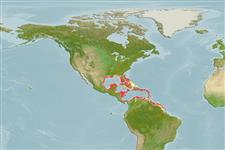>
Clupeiformes (Herrings) >
Dorosomatidae (Gizzard shads and sardinellas)
Etymology: Harengula: Old English haring, hering = mackerel, the fish Clupea harengus (Ref. 45335).
More on author: Cuvier.
Environment: milieu / climate zone / kisaran kedalaman / distribution range
Ekologi
laut; payau berasosiasi dengan karang; kisaran kedalaman 0 - 50 m (Ref. 188). Subtropical; 31°N - 7°S, 99°W - 47°W (Ref. 188)
Western Atlantic: Gulf of Mexico and southeastern Florida to northern Brazil, including the Bahamas, the entire Caribbean and the West Indies.
Length at first maturity / Size / Weight / umur
Kematangan: Lm ?, range 7 - ? cm
Max length : 22.5 cm TL jantan/; (Ref. 126891); common length : 10.0 cm SL jantan/; (Ref. 188); Berat maksimum terpublikasi: 109.00 g (Ref. 126891)
Duri punggung (Keseluruhan (total)) : 0; duri punggung lunak (Keseluruhan (total)) : 15 - 21; Duri dubur: 0; Sirip dubur lunak: 12 - 23. Tooth-plate on tongue and tooth plate behind it (basihyal and basibranchials tooth plates) broad, their width about 3 to 5 times in their combined length, the basibranchial tooth plate with a distinct bulge in front. Scales fairly strongly attached, not easily lost. No dark pigment on dorsal fin tip (Ref. 188). Silvery, with a dark greenish back. Diffuse yellow or pale orange spot at edge of opercle. Body slender, lower profile not strongly curved (Ref. 7251).
Body shape (shape guide): fusiform / normal; Cross section: compressed.
Occurs in coastal waters, estuaries and lagoons, tolerating low salinities. Can tolerate a broad range of salinity levels (Ref. 26938). Forms schools, small individuals often along sandy beaches. Its flesh has an unpleasant odor. Utilized as fishmeal (Ref. 5217).
Life cycle and mating behavior
Kematangan | Reproduksi, perkembang biakan | Pemijahan | telur-telur | Fecundity | Larva
Whitehead, P.J.P., 1985. FAO Species Catalogue. Vol. 7. Clupeoid fishes of the world (suborder Clupeoidei). An annotated and illustrated catalogue of the herrings, sardines, pilchards, sprats, shads, anchovies and wolf-herrings. FAO Fish. Synop. 125(7/1):1-303. Rome: FAO. (Ref. 188)
Status IUCN Red List (Ref. 130435: Version 2025-1)
ancaman kepada manusia
Harmless
penggunaan manusia
Perikanan: nilai komersial kecil; umpan: usually
Alat, peralatan
laporan khas
muat turun XML
Sumber internet
Estimates based on models
Preferred temperature (Acuan
123201): 24.3 - 28, mean 26.8 °C (based on 230 cells).
Phylogenetic diversity index (Acuan
82804): PD
50 = 0.5625 [Uniqueness, from 0.5 = low to 2.0 = high].
Bayesian length-weight: a=0.00871 (0.00777 - 0.00976), b=3.07 (3.04 - 3.10), in cm total length, based on LWR estimates for this species (Ref.
93245).
Trophic level (Acuan
69278): 3.3 ±0.3 se; based on diet studies.
Generation time: 2.6 ( na - na) years. Estimated as median ln(3)/K based on 1
growth studies.
Daya lenting (Acuan
120179): Tinggi, Waktu penggandaan populasi minimum kurang dari 15 bulan (Preliminary K or Fecundity.).
Fishing Vulnerability (Ref.
59153): Low to moderate vulnerability (28 of 100).
🛈
Nutrients (Ref.
124155): Calcium = 64.6 [30.1, 127.7] mg/100g; Iron = 1.01 [0.50, 1.87] mg/100g; Protein = 20.1 [18.8, 21.4] %; Omega3 = 0.39 [0.21, 0.71] g/100g; Selenium = 14.5 [6.7, 31.4] μg/100g; VitaminA = 65.7 [20.2, 208.6] μg/100g; Zinc = 1.1 [0.7, 1.8] mg/100g (wet weight);
